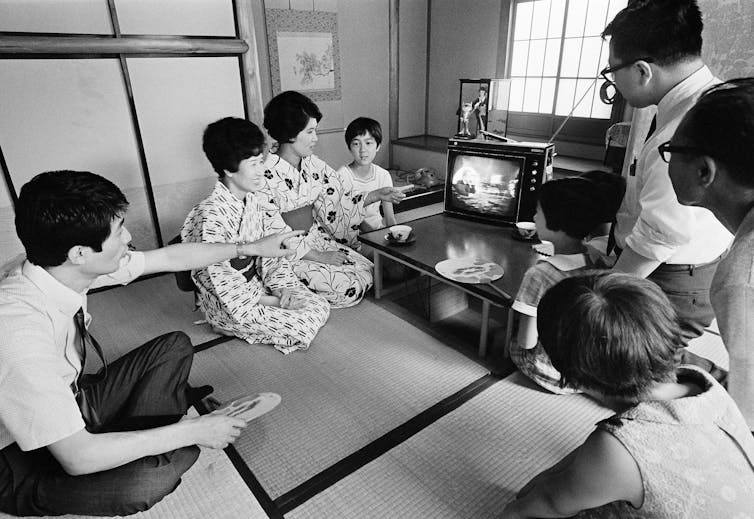Young Americans deserve a 21st-century Moonshot to Mars
- Written by Vahe Peroomian, Associate Professor of Physics and Astronomy, University of Southern California – Dornsife College of Letters, Arts and Sciences
“Hidden Figures”[1] and “First Man”[2] were arguably the most inspirational space-themed movies of the last several years. Both, though, had to reach back to the glory days of John Glenn and Neil Armstrong. The faces of my children after watching these movies was the surest sign of a missed opportunity, of a generation raised without a Moonshot.
Back on July 20, 1969, around the globe, millions sat glued to their black-and-white television sets, waiting for history to be made. “Houston, Tranquility Base here… the Eagle has landed[3]” marked not just a successful Moon landing but much more. It was the culmination of a Moonshot begun with John F. Kennedy’s famous speech in 1962[4], an endeavor that set the U.S.‘s sights on winning the space race. Fifty years on, I believe the United States needs another “Moonshot[5],” a seemingly impossible task that rallies everyone from engineers and scientists to teachers and generations of students toward that goal. This Moonshot is necessary not because more flags need to be planted and more footsteps left behind on a distant world, but because of the need to inspire present and future generations as mine was with the advent of the Space Age.
The Apollo program, the Moonshot of my generation, inspired me to earn a Ph.D. in physics and carry out several decades of research in space science[6], with an ever-increasing passion for teaching. Now, each time I step into my astronomy classroom, it’s my own sense of wonder, the sense of exploration I felt as a child, that I try to instill in my students.
 A Japanese family watches their TV screen as President Richard Nixon is superimposed on a live TV broadcast of the Apollo 11 astronauts’ salute from the Moon, July 21, 1969.
AP Photo[7]
A Japanese family watches their TV screen as President Richard Nixon is superimposed on a live TV broadcast of the Apollo 11 astronauts’ salute from the Moon, July 21, 1969.
AP Photo[7]
Growing up in the Space Age
At four years of age and living in Tehran, Iran, I wasn’t old enough to stay up late to watch the first Moon landing, as it occurred just before midnight, local time. But I was old enough to remember the craze that swept the planet, the pride everyone felt for humankind, and the crowds that showed up to greet the astronauts on their world tour, an awestruck four-year-old among them.
I was the perfect age. I was old enough to grow up with the Moon landings, the Saturn V rocket[8], the Lunar Module[9] and the bulky spacesuits of the astronauts to hijack my imagination, for my drawings to be exclusively of space adventures and for the games I played with my younger brother based on the exploration of imaginary Moonscapes. By the time the Apollo 17 mission[10] returned from the Moon in December 1972, I had already been captivated by the brave astronauts. Like many in my generation, I aspired to be an astronaut when I grew up. The successful Moonshot defined our generation as no peaceful world event ever had.
Over the years, I breathlessly watched the Viking spacecraft[11] land on Mars. I held my breath as Space Shuttle Columbia[12] blasted off to space in 1981, rushed over to Edwards Air Force Base in the Mojave Desert to watch as the very same spacecraft gracefully glided to a perfect landing and cried my heart out when Space Shuttle Challenger exploded[13] soon after liftoff. Every sci-fi TV show and movie I watched as an adolescent and young adult, and I watched plenty, portrayed Moon bases and human exploration of the solar system by the turn of the 21st century.
I wonder, what is the Moonshot of this generation? What is the event that can inspire them with the sense of wonder that the Apollo Moon landings did for my generation? Nowadays, becoming a pro athlete is the top dream career[14] of kids of all ages, and being an astronaut has been booted out of the top 10. How did we get here?
Excuses aplenty
For the last 50 years, every argument has been made against human exploration of the solar system. The Apollo program was too costly[15]. Robotic spacecraft can do the job[16]. Sending astronauts to Mars and beyond is dangerous[17].
And so, in my opinion, today’s space enthusiasts have wallowed in the menial and mundane successes of the astronauts on board the International Space Station. Those of us arguing for a return of human exploration of the solar system have pinned our hopes of returning to the Moon and sending humans to Mars not on a well-planned space program, but on a space race driven by the egos[18] of the nouveau-billionaires of the 21st century[19].
Sure, NASA has spent these decades notching success after success, landing rovers on Mars and visiting every planet in our solar system. Which of these events did a four-, seven- or 10-year-old child watch or even remember? Which of these glued an entire planet to their TV sets? Which of these trained an entire generation as engineers, scientists and leaders?
None of these, of course.
One may argue that Moonshots are a thing of the past. Perhaps it’s better that kids today are more grounded and less prone to lofty ideals. But I disagree. I look at the effect the space race had on not just my generation, but on those that worked to make the Moon landing a reality: the thousands of scientists and engineers who were trained for that singular goal, and the millions after that were inspired by these deeds.
 New York City welcomes the Apollo 11 crew. Pictured in the lead car, from the right, are astronauts Neil A. Armstrong, Michael Collins and Buzz Aldrin.
NASA[20]
New York City welcomes the Apollo 11 crew. Pictured in the lead car, from the right, are astronauts Neil A. Armstrong, Michael Collins and Buzz Aldrin.
NASA[20]
Moonshot as inspiration
I then see the decline in scientific education in the U.S.[21], the decline in interest in the sciences[22] and statistic after statistic showing American high school students ranking below the international average in mathematics[23] and science[24] proficiency. Is it surprising, then, that NASA is having trouble in every step of its meager plan for landing humans on the Moon again?
I cannot help but think that all this would change should the U.S. challenge itself with a Moonshot once again. And no, a return to the Moon won’t do. A real Moonshot isn’t a single mission, but a decades-long plan that educates generations, challenges its scientists and engineers, ignites the imagination and aspirations of its children, and once again glues the eyes of humanity on the livestream of that first footstep on Mars.
The Moonshot we need will have humanity establishing its first off-world colonies. It will send the first spacecraft to the distant stars. It will, more importantly, restore the United States to the forefront of science and technology. Fifty years after that first giant leap for mankind, it is finally time to take not just the second leap, but each and every leap that we’ve prevented ourselves from taking for five long decades.
References
- ^ “Hidden Figures” (www.imdb.com)
- ^ “First Man” (www.imdb.com)
- ^ Houston, Tranquility Base here… the Eagle has landed (www.nasa.gov)
- ^ John F. Kennedy’s famous speech in 1962 (er.jsc.nasa.gov)
- ^ Moonshot (whatis.techtarget.com)
- ^ several decades of research in space science (scholar.google.com)
- ^ AP Photo (www.apimages.com)
- ^ Saturn V rocket (www.nasa.gov)
- ^ Lunar Module (nssdc.gsfc.nasa.gov)
- ^ Apollo 17 mission (www.nasa.gov)
- ^ Viking spacecraft (mars.nasa.gov)
- ^ Space Shuttle Columbia (www.nasa.gov)
- ^ Space Shuttle Challenger exploded (www.youtube.com)
- ^ becoming a pro athlete is the top dream career (www.forbes.com)
- ^ The Apollo program was too costly (qz.com)
- ^ Robotic spacecraft can do the job (www.wired.com)
- ^ Sending astronauts to Mars and beyond is dangerous (www.bbc.com)
- ^ a space race driven by the egos (www.ccn.com)
- ^ nouveau-billionaires of the 21st century (singularityhub.com)
- ^ NASA (www.nasa.gov)
- ^ decline in scientific education in the U.S. (americanaffairsjournal.org)
- ^ interest in the sciences (www.govtech.com)
- ^ mathematics (hechingerreport.org)
- ^ science (www.pewresearch.org)
Authors: Vahe Peroomian, Associate Professor of Physics and Astronomy, University of Southern California – Dornsife College of Letters, Arts and Sciences
Read more http://theconversation.com/young-americans-deserve-a-21st-century-moonshot-to-mars-118108

